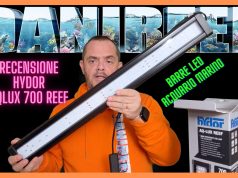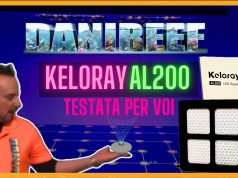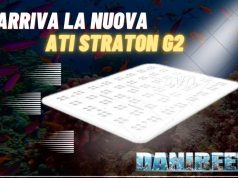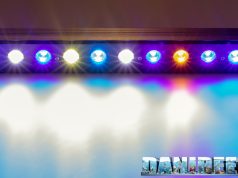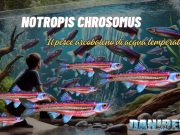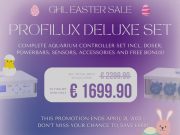How to value these numbers in aquarium?
This is a good question. At first we thought that we could transport these values to the aquarium tout-court. Than we filled the aquarium, insert the probe and redone the measurements. We fazed but, as we have already said in elsewhere, we’re going to talk about this in another article. Basically, while at 20 cm the result is practically the same, as we progressed, thanks to the glass and the water itself reflecting the light, we found even the double of the values measured in air. Obviously this isn’t a detail that can be standardized, so we think that our method of calculation is the most correct, and the best for the comparison of coverages of different ceiling lights.

Power Consumption
The measurement of the consumption was made possible thanks to the useful device RCE PM600 that can also measure the Cos(fi) (or power factor). The result is already given in watt.

Here above there’s the maximum power and below the Cos(fi).

The calculus of the absorbed current, that is the power, is the following one:
Orphek OR3 Blue Sky ceiling light: 62,04 watt. Considering that this ceiling lights at 17 cm has 488 μmol m-2 s-1 in the middle, we can say, in perspective, that it will have a peak value of 7,86 μmol m-2 s-1 w-1 (PAR per watt). This value is hardly comparable with other ceiling lights because it remains constant throughout the length.
The consumption is slightly higher than declared, while the Cos(fi) is very close to 1, the perfect value.
The comparison with other ceiling lights on the market
Recently we started to use the new Quantum Meter MQ-510 by Apogee.
But considering the first celing lights we managed to test we can do an interesting comparison about their produced energy:
| Energy | Cost | Consumption | Energy/€ | Energy/w | |
| AI Hydra 32 HD at 17 cm | 560.000 | 430 | 90,50 | 1.303 | 6.190 |
| AI Hydra 32 HD at 37 cm | 563.000 | 430 | 90,50 | 1.310 | 6.224 |
| AI Hydra 32 HD at 57 cm | 463.000 | 430 | 90,50 | 1.076 | 5.112 |
| Aqamai LRM at 17 cm | 643.000 | 465 | 90,88 | 1.382 | 7.071 |
| Aqamai LRM at 37 cm | 722.000 | 465 | 90,88 | 1.552 | 7.941 |
| Aqamai LRM at 57 cm | 616.000 | 465 | 90,88 | 1.326 | 6.783 |
| Aqamai LRS at 17 cm | 276.000 | 289 | 47,59 | 955 | 5.797 |
| Aqamai LRS at 37 cm | 312.000 | 289 | 47,59 | 1.078 | 6.547 |
| Aqamai LRS at 57 cm | 254.000 | 289 | 47,59 | 880 | 5.343 |
| Cetus 2 at 17 cm | 410.000 | 215 | 60,68 | 1.906 | 6.756 |
| Cetus 2 at 37 cm | 291.000 | 215 | 60,68 | 1.353 | 4.793 |
| Cetus 2 at 57 cm | 174.000 | 215 | 60,68 | 807 | 2.861 |
| Orphek OR2 Blue Plus 120 cm at 17 cm | 323.000 | 180 | 54,69 | 1.794 | 5.906 |
| Orphek OR2 Blue Plus 120 cm at 37 cm | 291.000 | 180 | 54,69 | 1.616 | 5.321 |
| Orphek OR2 Blue Plus 120 cm at 57 cm | 259.000 | 180 | 54,69 | 1.438 | 4.736 |
| Orphek OR3 Blue Sky at 17 cm | 318.000 | 200 | 62,04 | 1.590 | 5.129 |
| Orphek OR3 Blue Sky at 37 cm | 220.767 | 200 | 62,04 | 1.103 | 3.449 |
| Orphek OR3 Blue Sky at 57 cm | 205.518 | 200 | 62,04 | 1.027 | 3.211 |
| Orphek OR2 Reef Day Plus 120 cm at 17 cm | 255.000 | 180 | 54,69 | 1.418 | 4.667 |
| Orphek OR2 Reef Day Plus 120 cm at 37 cm | 233.000 | 180 | 54.69 | 1.292 | 4.252 |
| Orphek OR2 Reef Day Plus 120 cm at 57 cm | 225.000 | 180 | 54.69 | 1.251 | 4.117 |
| Philips CoralCare at 17 cm | 1.859.000 | 749 | 190,50 | 2.481 | 9.756 |
| Philips CoralCare at 37 cm | 1.341.000 | 749 | 190,50 | 1.790 | 7.037 |
| Philips CoralCare at 57 cm | 933.000 | 749 | 190,50 | 1.246 | 4.899 |

The prices in the chart should be revised, because now the OR2 cost more. Apart from that, the values are more or less the same. The OR3 Blue Sky have a higher peak value, but a lower value on the sides. What makes the difference is the spectre, that can easily make this one your favorite bar. I personally like a lot this Blue Sky. Don’t let mislead from the high value of PAR, because having a predominance of blue its behavior is different from the others.
Mantaining costs
The LED bars Orphek OR3 Blue Sky cost 215 euros, and finally in Italy we have a great distributor: AGP.
The absorbed power is 62 watt, so it has a cost/watt ratio of 3,2 euro for each watt. In order to do a comparison with the other ceiling lights you can refer to this chart:
| Ceiling light | Price | Consumption | Euro per watt ratio | References |
| Orphek OR3 120 Blue Sky | 200 USD | 62 w | 3,2 euro per watt | DaniReef LAB |
| Orphek OR2 120 Blue Plus | 180 USD | 54.7 w | 3,3 euro per watt | DaniReef LAB |
| Orphek OR2 120 Reef Day Plus | 180 USD | 54,7 w | 3,3 euro per watt | DaniReef LAB |
| Cetus 2 | 215 € | 60,7 w | 3,5 euro per watt | DaniReef LAB |
| Philips Coralcare 2019 | 749 € | 190 w | 3,9 euro per watt | DaniReef LAB |
| Maxspect Ethereal | 500 € | 126 w | 4,0 euro per watt | Italian test |
| Radion XR30w G2 PRO | 790 € | 170 w | 4,7 euro per watt | Italian review |
| AI Hydra 32 HD | 430 € | 90,5 w | 4,75 euro per watt | DaniReef LAB |
| Radion XR30w G4 PRO | 915 € | 190 w | 4,84 euro per watt | Italian article |
| OceanLed Sunrise 600 | 870 € | 180 w | 4,8 euro per watt | Italian test |
| Orphek Atlantik V4 | 1099 € | 226 w | 4,9 euro per watt | Test |
| Radion XR30w G2 | 690 € | 140 w | 4,9 euro per watt | Italian review |
| Radion XR30w G4 | 760 € | 150 w | 5,1 euro per watt | Italian article |
| Aqamai LRM | 465 € | 87,5 w | 5,1 euro per watt | DaniReef LAB |
| Zetlight UFO ZE-8000 | 500 € | 91,5 w | 5,5 euro per watt | Test |
| Aqamai LRS | 289 € | 47,6 w | 6,1 euro per watt | DaniReef LAB |
| CEAB Slide & Led | 2.700 € | 275 w | 9,8 euro per watt | Review |
| Sicce GNC 466 | 1.592 € | 120 w | 13,3 euro per watt | Italian review |

As well as we have said for the OR2 Reef Day Plus and Blue Plus, this LED bar is impeccable, very well build. I really like the extruded borders as well as the refinement. There isn’t a programming that assures a simple modality of use, you can also assit it with other bars in other to obtain the power you need. In this contest we have to focus on the measured PAR, given that that’s not possible to do a proper comparison with other ceiling lights. But if you consider the whole energy you have a more realistic picture. So the bars are perfect for breeding corals, but you have to take the bars you need. Do you need twice the PAR? Use two bars. Do you need four times the PAR? Use four, and so on. What else to ask to a LED bar? According to me, 4 LED bars should let us get 600 PAR in a medium aquarium, and with such a value you can breed Acropore of any complexity.
The cost per watt is incredibly low, the lowest among the one we tested, while before we comment the value of PAR per watt we have to test other blue bars. What else we should ask to a LED bar?

Questions and comments, as always, are welcomed.








